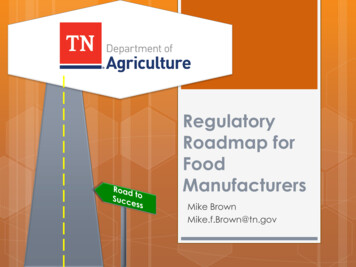
Transcription
RegulatoryRoadmap forFoodManufacturersMike BrownMike.f.Brown@tn.gov
Rules for AllFoodManufacturersto Play By
Good Manufacturing Practices Manufactured in a sanitaryenvironment adhering to GoodManufacturing Practices (GMPs)21CFR Part 117 Process controls (proper cookingtime and temperature)Ingredient handling/storagePest controlCleaning and sanitationSanitary equipment and utensildesignAllergen controlPersonal hygiene
GMP Training & Resources Cornell http://gmptraining.dyson.cornell.edu/Very Comprehensive course 50 UT GMP Online TrainingPublicationsGetting Started in a FoodManufacturing Business in TennesseeAdding Value to Agriculture ThroughCommercial Food ProcessingEnterprises
UTK FST Extension Publications
Product Labeling The Four Must HavesProduct nameManufacturers name and address Or name, city and zip if listed in white pagesNet weight of product in English and Metricunits e.g.ounces/pounds and gram weightequivalent or milliliters/liters and fluid ounces Complete list of ingredients in order ofpredominance by weight
Allergens Food Allergen and Consumer Protection Act January 1, 2006Any of the “Big 8” allergens properlyidentified in ingredient statement Wheat Soy Milk Eggs Fish Shellfish Peanuts Tree nuts (e.g. almonds, cashew, brazil nuts)Statement after ingredients “Contains: ”
Allergens
Advisory Labeling Statements Advisory Labeling“May contain ”“Made on shared equipment ”“Made in a facility that ”
ProductNameName ofDistributor orManufacturer withStreet Address
Weight ingrams andounces
Didwe miss anything?Ingredients: apples,honey, apple cider,citric acid, salt, spices
Nutrition Facts Panels Small Business ExemptionFile notice with FDA Salesof less than 100,000units AND 100 full-timeemployees Notice does not need tobe filed with FDA Grosssales of less than 50,000
Nutrition Facts Panels Two Methods1) Laboratory Based Nutritional Analysis Requirea physical sample of the product The samples are then prepped and analyzed inthe laboratory using various scientificinstruments and techniques to yield data that isspecific and unique to the product. Laboratory based nutritional analysis can beused for virtually any food type.
Nutrition Facts Panels Two Methods2) Nutritional Database Analysis Requiresthe formula for the product Detailed information about each ingredientand product processing information No physical sample is required to be submitted Database analysis can be used for productsthat have common ingredients. Not recommended: Productsthat have unique or exotic ingredients, Products with ingredients for which there is nonutritional data available, or Products that undergo extensive processing.This method can only be used for human foods.
Nutrition Facts Panels Two 1)MethodsLaboratory Based Nutritional Analysis Approx. 800-1,500 Refer to outside testing lab 2) Nutritional Database Analysis 100-300 Online as well as outside testing labs
AcidifiedFoods
Acidified Foods Foodswith 10% by weight inparticulates that are low acid (pH 4.6) VegetablesEggsNuts Examples:salsa, pickles, chow-chow
Acidified Foods Mustadhere to GMPs as well as acidifiedfood regulations Manufactured in commercial facility Community kitchen - rent timeRent time from a restaurant/cater whileclosedCo-packer- another companymanufacturer your product Require minimum batch sizesBuild their own Inspectedand permitted as commercialfood manufacturer
What are the additionalrequirements for acidifiedfoods?1) One time educational course
Better Process Control School Educatesmanufactures of the acidifiedfood requirements Microbiology- food safetyProcess controls- cook time/temperatureProduct measurements – pHRecords
What are the additionalrequirements for acidifiedfoods?1)2)One time educational courseRegister your facility with FDA
Registering Your Facility Form2541 Just file one time for each location youprocess lsForms/Forms/UCM076778.pdf
What are the additionalrequirements for acidifiedfoods?1)2)3)One time educational courseRegister your facility with FDAWork with a processing authority toestablish a scheduled process for eachproduct
Who is a Processing Authority? Someonewith expertise knowledge inmicrobiology and thermal processing Charge a fee per recipe to establish process May need to come on site while youmanufacture to collect data
What are the additionalrequirements for acidifiedfoods?1)2)3)4)One time educational courseRegister your facility with FDAWork with a processing authority toestablish a scheduled process for eachproductFile Scheduled Process with FDA
Filing a Scheduled Processwith FDA FDAForm 2541a NOW 2541e Specific to the product Documents critical factors established byprocessing authority
What are the additionalrequirements for acidifiedfoods?1)2)3)4)5)One time educational courseRegister your facility with FDAWork with a processing authority toestablish a scheduled process for eachproductFile Scheduled Process with FDAKeep accurate records documenting allcritical factors each time you process
Examples of Records Thermal Cookprocessing recordstime, temperature Finishedproduct pH Fill weights Solid fill weight
Acidified Food Resources Factsheetto assist acidified foodmanufacturers
FDA Resources and GuidanceDocuments 7436.htm ult.htm
FormulatedAcid Foods
Formulated Acid Foods Foods with natural pH 4.6Usually 3.3-3.5 Lessthan 10% by weight particulatelow acid foods Most of our sauces and dressings fallinto this category BBQ sauce, mayonnaise andmarinades
Formulated Acid Foods Stillrecommend review of productformulation and processing steps Must adhere to GMPs Manufactured in a commercial kitchen DO NOT have additional requirements foracidified foods Can voluntarily submit 2541e to FDA forreview
Formulated Acid FoodsMaterials Factsheetto assist formulated acid foodmanufacturers
CottageFood Laws
Cottage Food Industry Growing support for home-made products Allows producers to add value to fruit andvegetable crops they raise A start to your business- not the end game Applies ONLY to non-potentially hazardous foods? Varies from state to state
What are non-potentiallyhazardous foods? Good Thesequestion!foods don’t supportthe growth of bacteria thatcan be harmful
Can I get a list of nonpotentially hazardous foods? No! Wide range of productsFruit jams and jelliesApple buttersDried pumpkin and spinach pastaDried herbs Contactme to determine if your productfits into this category
Domestic Kitchen Rules InApril 2017, a law was passed whicheliminates the permit requirement by theTennessee Department of Agriculture
Domestic Kitchen Products Must be properly labeledProduct nameManufacturers name and addressNet weight of product in ounces/pounds andgram weight equivalentComplete list of ingredients in order ofpredominance by weightAny of the “Big 8” allergens properlyidentified- wheat, soy, milk, eggs, fish,shellfish, peanuts, tree nuts,
Domestic Kitchen Course Online extOL Certifications 75404 students since Feb. of gory.php?id 25 Inperson classes on demand- 10 peopleminimum 1008 hours
Other FoodTypes
Retail Meat Sales Animals processed, meatpackaged and labeled atUSDA inspected facilityTransported in a securemanner - freezer operated byinverter is acceptableNo re-freezing of product –refrigerated productmaintained at or below 41FRetail Meat Sales Permit fromTDA
Retail Meat Sales Labeling Requirements Product name.Name and address of the place of business of the manufacturer,packer or distributor (“packed for ” or “distributed by ” areacceptable).USDA mark of inspection/establishment number.Net weight.Safe handling instructions.Ingredients (if more than a single ingredient product).Price per pound (non-frozen, random weight packages only).Total price (non-frozen, random weight packages only).Optional Code date or lot number. (Recommended not required.)Special statement and claims. (Require approval by USDA.)
Retail Meat Sales
Poultry Producer/Grower 20,000 birds/yearExemptionExempt from inspectionMay sell to consumer, hotel, retail stores, andrestaurants/institutionsLabeling: The shipping containers, whendistributed in intrastate commerce, (instead of allthe required features of a label for inspectedproduct) bear: The processor’s nameThe addressNet weightThe statement, Exempt P.L. 90-492Safe handling instructions
Exemption Provisions Thepoultry is healthy whenslaughtered; The slaughter and processingare conducted under sanitarystandards, practices, andprocedures that producepoultry products that aresound, clean, and fit forhuman food (notadulterated); The poultry is not misbranded,is identified as exemptproduct and labeled;
Exemption Provisions The business operates under only 1 exemption duringcalendar year;Product cannot bear the Official USDA mark of inspection;andPoultry products do not move in inter-state commerce.The business slaughters and processes no more than20,000 birds/carcasses in a calendar year under theexemption.Facility used to slaughter or process poultry is not used toslaughter or process another person’s poultry unless theAdministrator of FSIS grants an exemption [9 CFR 381.10(b)(2)].
Dairy Products Milk,cream and mixesmust be pasteurized inproperly operated anddesigned equipment in alicensed and permitteddairy plant EXCEPTIONS:1.2.Raw milk hard cheese –processed in dairy facility– cheese aged 60 daysIce cream made frompasteurized mix, cheeseballs, cheese cake etc.
Eggs No permit/inspection required 3,000 birds 18,000 eggs must be gradedLimit of 50 cases (30 doz per case)of unclassified eggs per year 18,000 eggsMust be from own flock- nodistributorsCleaned and sanitizedUnused containersMust be labeled UnclassifiedName and address of producerEggs deemed adulterated may notbe offered for saleStore at or below 41ºF
Honey No permit/inspectionrequired 150 gallons per yearOnly sell product youproduce Must be labeledHoneyComb honeyCut comb honey, Honey withcomb, Chunk honeyName, address, & net weight
Newly Defined Standard ofIdentity TCA – chapter 0080-04-12Honey and any flavoring, spice orother added ingredientProcessed in such a way that amodification to honey occurs thatmaterially changes the flavor, color,viscosity or other materialcharacteristicsMust be distinguished in the foodname from honey by declaration ofthe food additive or modification.
Sorghum Molasses Must be labeledName, address, &net weight“100% PureSorghum Molasses”“Not Pure SorghumMolasses”- Includeingredient listing Inspectedby TDA
Fresh Cut and Shelled Produceor Nuts Freshproduce that has been cut,shredded, sliced, chopped, torn, orshelled Maintain cut produce at 41 F or less duringstorage and displayWill need to be processed in a facility inspectedand permitted by TDA
Weights And Measures "Freshfruits andvegetables may be sold byeither weight, count.head/bunch, dry measure,or a combination ofthese methods of saleas specified in NISTHandbook 130".
Weights And Measures Scalesused for retail sale must meet appropriatestandards & inspected by TDA Nat’l Type Evaluation Program (NTEP) AnnualTDA inspection & permitfees – up to 5 scales( 2500 lbs.) 25.00 Non-compliant scales must berepaired by registered servicecompany – TDA has a list Net Wt. only – lbs. ozs. & grams. Questions – Ed Coleman– 615837-5144 or ed.coleman@tn.gov
Pet Food/Treats Requirespermit andinspection Contact Mark Powellfor details Mark.powell@tn.gov 615-837-5135
Tennessee Department ofAgriculture Business DevelopmentMike Brown– Food Business ConsultantMike.F.Brown@tn.gov(615)837-5545Will send packet for you to complete andsend back for their review Inspectioncategoryfrequency is based on risk
University of Tennessee CountyExtension Office Department of Food Science &Technology Nathan Millernmille12@utk.edu865-974-7287
Milk, cream and mixes must be pasteurized in properly operated and designed equipment in a licensed and permitted dairy plant EXCEPTIONS: 1. Raw milk hard cheese - processed in dairy facility - cheese aged 60 days 2. Ice cream made from pasteurized mix, cheese balls, cheese cake etc.











